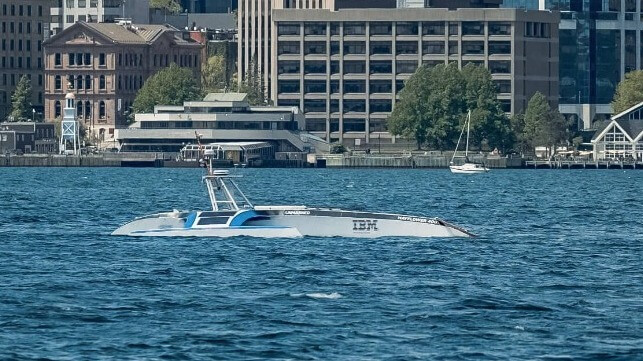Mayflower Autonomous Ship Completes Historic Atlantic Crossing

Just over two months after setting off from England, and with two unplanned “pit stops,” the uncrewed Mayflower Autonomous Ship (MAS) arrived in Plymouth, Massachusetts on June 30. Towed the final 25 miles due to U.S. Coast Guard regulations against the operation of uncrewed vessels in coastal areas, the vessel is now docked alongside a replica of her namesake.
She became the largest uncrewed vessel to complete the trans-Atlantic crossing and is being hailed as a turning point in the development of autonomous technologies. The project was launched in 2016 by the non-profit maritime research organization ProMare with the goal of using artificial intelligence to aid in the collection of marine research data. IBM and others joined the project helping to develop the technology including six AI-powered cameras, more than 30 sensors, and 15 edge devices, all of which input into actionable recommendations for the “AI Captain” to interpret and analyze.
According to the technology team, the data coming from the sensors and the programming of the systems made it possible for the AI Captain to adhere to maritime law while making crucial split-second decisions, like rerouting itself around hazards or marine animals, all without human interaction or intervention. Further, the AI Captain learned from data, postulated alternative choices, assessed and optimized decisions, while managing risk to complete the crossing.
The Mayflower Autonomous Ship arrived @ the #Plymouth waterfront, docking near the #MayflowerTwo. The unmanned MAS made the 3k mi trip from Plymouth, UK, using AI, complex onboard systems & solar power. It also took water samples & collected info to better understand ocean health pic.twitter.com/JGouGhegjq
— Kim Tunnicliffe (@KimWBZ) June 30, 2022
We made it home ???????? pic.twitter.com/M4tf2CSkgV
— AI Captain - Mayflower Autonomous Ship (@AI_Mayflower) June 30, 2022
Having set out from England in April, it was the second attempt by the vessel to cross the Atlantic after a 2021 voyage was canceled due to a mechanical failure. The 2022 crossing was not without its mechanical problems causing the vessel first to divert to the Azores where problems were diagnosed and she was refueled. The team monitoring the voyage decided in June to divert to Halifax, Canada after experiencing additional mechanical problems. The Mayflower departed Canada on Monday, June 27 for the historic final leg of her journey, completing an estimated 3,900 nautical miles without a crew aboard. Plans to sail the Mayflower to Washington, D.C. appear to have been put on hold or canceled.
“This voyage is only just beginning,” Rob High, IBM’s chief technology officer for networking and edge computing told the Boston Globe after the vessel reached Massachusetts yesterday. He predicted that the experience gained during the trip would lead to more advancements in AI systems and could contribute to fleets or uncrewed vessels and the addition of the technology to commercial vessels to aid crews and “make their lives easier.”
Recent demonstrations in Japan and by South Korea’s Hyundai Heavy Industries have further demonstrated the potential for autonomous navigation. The Japanese program demonstrated ferries and containerships making local voyages and docking and undocking entirely controlled by computers. An LPG carrier demonstrated the technology by navigating for roughly half its voyage across the Pacific, or approximately 5,400 nautical miles avoiding over 100 ships and optimizing the voyage.
ProMare announced that further information about the upcoming projects for the Mayflower, the scientific research schedule, and upcoming local events to inform the public will be announced soon.
